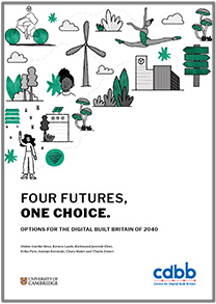
Submitted by Angela Walters on Fri, 11/12/2020 - 10:59
Four Futures, One Choice uses a futures thinking methodology to explore four scenarios for the digital built environment in the year 2040, hinging on the age demographics in the UK and the achievement of the Sustainable Development Goals. It demonstrates that a complex web of factors will determine what opportunities or needs will drive digitalisation.
This work occupies a new space in the scenario literature by considering the built environment in the context of an unprecedented climate and public health crisis, digitalisation and the UN’s Sustainable Development Goals. It is written in plain language to address industry leaders, decision makers and the general public in order to encourage action in light of a common vision of the future. At a moment of great uncertainty and crisis, it emphasises the need for broad resilience in society and the built environment and explores a range of decisions that can be made to support a future in which digitalisation enhances quality of life in the built environment.
Four Futures, One Choice was a one-off piece of work by a group of interdisciplinary researchers, and provides insight and inspiration to a broad audience. It recommends actions to be taken by individuals, industry leaders and decision-makers as we recover from COVID-19, including thoughtful investment in digital technology, prioritising decarbonisation and biodiversity, and shaping governance to ensure a better tomorrow.
The choice of what to do next is yours.
More information on this publication is available here and in this blog post.
Citation
Gürdür Broo, D., Lamb, K., Ehwi, R. J., Pärn, E., Koronaki, A., Makri, C., & Zomer, T., Four Futures, One Choice: Options for the Digital Built Britain of 2040, December 2020, Centre for Digital Built Britain. Cambridge, United Kingdom. DOI: 10.17863/CAM.59803
DOI: https://doi.org/10.17863/CAM.5980

